How Climate Change Affects The Global Poor
Climate alter is apace becoming climate crisis. Between 2030 and 2050, climate change is expected to cause approximately 250,000 actress deaths per year. That'southward from malnutrition, malaria, diarrhea and oestrus stress alone, says the Globe Wellness System.
Around the world, smog levels are making it harder to exhale. Food is becoming scarcer and less nutritious. Ascension rivers and raging wildfires make news headlines as they destroy neighbourhoods rooted for generations. In the United States alone, climate change doubled the number of large forest fires betwixt 1984 and 2015.
Only climate change doesn't bear on everyone to the same degree. Within Canada and effectually the earth, the poorest people are oftentimes most drastically impacted. Wealthier nations and families have more power to shield themselves from the impacts of climate modify:
- Money pays for air workout and cottages where air is fresher.
- College incomes allow people to live in prophylactic places, abroad from swelling rivers and tinder-dry wooded areas.
- Privilege fills grocery carts, fifty-fifty every bit nutrient prices soar.
- Wealthier federal budgets can compensate their citizens when climatic change harms livelihoods.
Impoverished families in developing countries are often the least to blame for man-made climate change. Yet they typically bear the worst of the impact.
Climatic change in developing countries
Without urgent action, climate change could button an boosted 100 million people into poverty, says the World Bank.
Imagine being a farmer, pastoralist or fisher in a low-income country. You're likely already struggling to provide for your family. You take no insurance, no savings to speak of and no social safety net. Just 1 in 5 of the poorest people in low-income countries is covered by social safety cyberspace programs, according to the World Bank.
Your well-being may be linked directly to land and h2o. Your collateral is your boat, your livestock or your next harvest. And your children's well-being is completely dependent on making a skilful harvest, selling healthy livestock or hauling in good catches of fish.
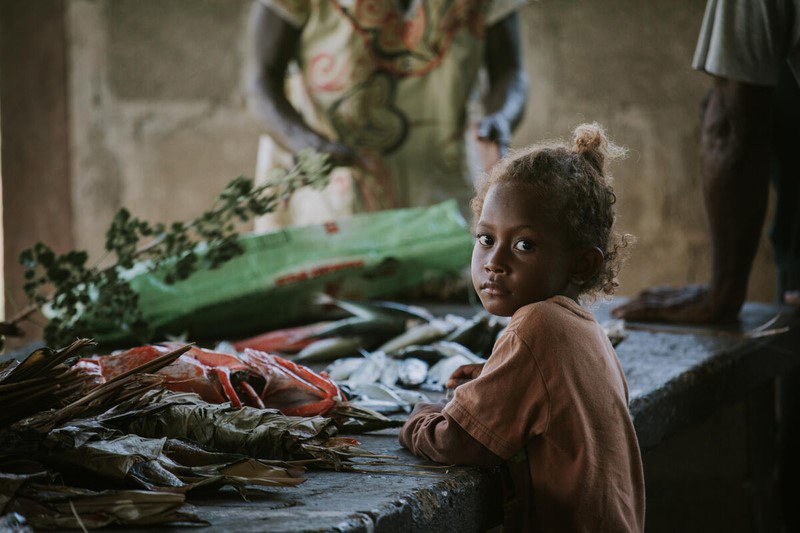
A child displays a small-scale grab at marketplace, on the Solomon Islands. Co-ordinate to the elders, in that location are no large fish anymore. Fishers spent all dark at work and catch very little. The h2o is warmer, the coral is bleaching and the tidal patterns have inverse. Almost fish have gone elsewhere. Photograph: Klever Gaspar
Now, cistron in the impacts of climate change. Remove predictability from local rain patterns. Bring on the drought. Send in extreme weather phenomena: wildfires, hurricanes and tornadoes brought almost by climate change.
Such threats to life and livelihood are condign more common, increasingly intense and longer lasting than anyone remembers.
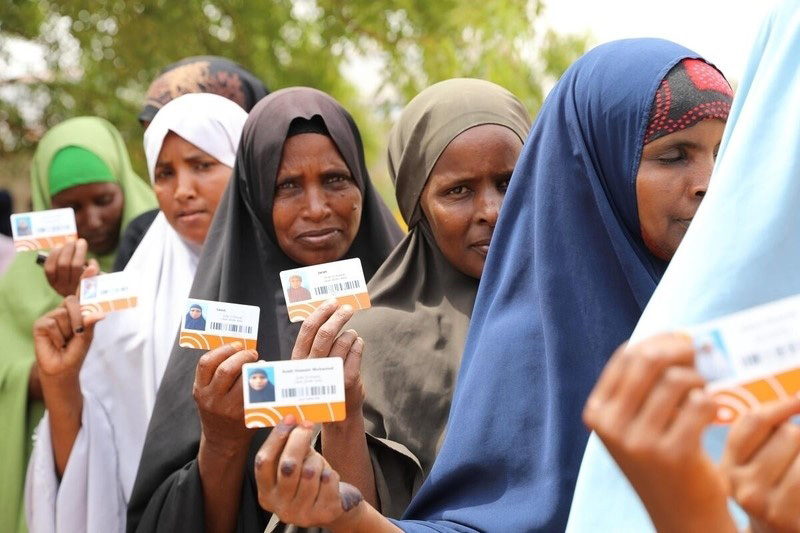
In a region of Ethiopia weakened by severe drought, mothers line up to receive their cash distribution from World Vision. They will use the funds to buy food and to buy food and other essentials for their families. Photo: Fitalew Bahiru
The rising bear upon on people
It took the globe a while to wake up to the devastation of climatic change. In the 1990s, well-nigh of our focus was on melting polar ice caps and its effect on species like polar bears. There is no question these issues are critically important and deserve our ongoing attention.
Just in the early 2000s, a new field of climate-scientific discipline research emerged. Information technology explored the homo bear upon of extreme weather such as floods, heatwaves, droughts and storms. Climatic change, it became increasingly clear, is affecting not just landscapes – but world poverty.
In 2010, the Un declared that "climatic change is inextricably linked to poverty and hunger." Seventy-five per cent of the earth's poor living in rural areas count on natural resources such as forests, lakes and oceans for their livelihoods, the system noted. And climate change is playing havoc with those resources.
Here's how climate change is impacting families and communities in some of the world'south poorest countries today:
- Prolonged droughts devastate food supplies and dry up water sources.
- Withered crops and starving animals destroy families' livelihoods.
- Hurricanes, floods and landslides flatten or sweep away people's homes.
- Strife can occur inside communities, every bit families compete for available arable state.
- Families become separated, as relatives relocate to search for work.
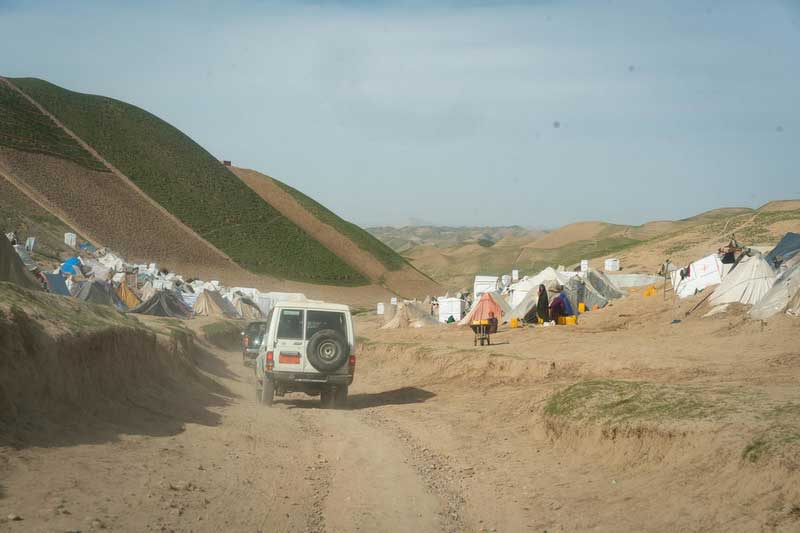
A devastating drought in western Transitional islamic state of afghanistan has pushed more than six one thousand thousand people to the brink and hundreds of thousands of people accept been forced to carelessness their homes to live in sprawling makeshift camps near cities in a desperate bid to feed their families. Photograph: Brett Tarver
The impact of climate change on children
According to the International Labour Organization, children are most vulnerable to the effects of climate change, natural disasters and extreme weather phenomena. And the impact of climate change tin be peculiarly harsh for children in low-income countries. When communities brainstorm at a disadvantage, the ravages of climate modify are more farthermost for the children living there.
Consider kid health. In developing countries, the wellness of children is already essentially worse than in countries like Canada. Children in developing countries are 10 times more than likely to die before the historic period of v than children in developed countries.
Now factor in the growing effects of climate alter like hotter days, water shortages, an increase in infectious illnesses, flooding and natural disasters and air pollution.
As climatic change worsens, so likewise does its effect on children's lives. For example:
- As ponds and rivers dry up, children must walk farther to fetch h2o.
- As food runs brusque and clean water sources disappear, malnutrition and dirty h2o can crusade illness.
- As parents lose income, children's illnesses tin go untreated when parents can't pay for medical help.
- As climate alter triggers displacement or migration, children are removed from the prophylactic of community.
- As family resources disappear, children may be pulled from school and sent to work.
Children'southward teaching can be affected by the impacts of climate change. Education is one of the best ways to convalesce poverty and reduce vulnerability to climate change and natural disasters. Nonetheless this written report from the Academy of Maryland indicates that climatic change can threaten schooling. The extreme rut and precipitation from climate change in tropical countries could bear upon children's power to finish loftier schoolhouse.

In Republic of angola, 16-yr-quondam Ndjiole quit schoolhouse to save his family's livelihood. For 6 months, he'southward been wandering in the bush with the family'due south cattle, searching for water and vegetation to keep them alive. Photograph: Antonio Matimbe
World Vision workers met this sixteen-yr-erstwhile boy, Ndjiole, at a UN h2o bespeak for animals. The boy had dropped out of schoolhouse to care for his family'southward cattle. Ndjiole left home six months ago. He sleeps in the bush with just the cattle for visitor. There's no shelter. He eats what he can find forth the way. The environs is hostile and he misses the comfort of a loving home.
Climate change is a contributing factor for the 152 one thousand thousand children nether the age of 18 working around the earth, says the International Labour Organisation. And the loss of education is just one aspect of the tragedy.
Children can exist hurt, maimed or even killed doing whatever work is bachelor in a hunger crunch. Lack of protection outside of school – and the drastic need to work – can go out children vulnerable to exploitation and trafficking. When families migrate in search of work, children are even more vulnerable, exterior the protection of their communities.
Climate change is especially brutal for girls. As communities grow increasingly destitute, parents may cull to arrange a child matrimony for their daughter. The number of girls married in childhood currently stands at 12 1000000 per year. Climate change is among the factors threatening to increase those numbers.
Unless progress is made to reverse the trend, more than 120 million additional girls will ally before historic period xviii past 2030, says UNICEF.

In Angola, girls as young as 12 are prostituting themselves to help proceed their families live during the worst drought in decades. Nutrient prices have soared. This 15-yr-one-time girl is struggling to feed herself, her mother and her grandmother. Photograph: Brianna Piazza
In some tragic cases, climatic change contributes to situations forcing girls to sell sex to stay alive. World Vision has reported that girls in southern Africa as young as 12 are selling sex to survive the hunger crisis. The price is roughly the same as a loaf of breadstuff.
"The United Nations says a record 45 one thousand thousand people in southern Africa face up hunger amid a 'silent ending'," reported the Thomson Reuters Foundation. The catastrophe is "caused by repeated drought, widespread flooding and economic chaos."
Regions of southern Africa have received their everyman rainfall since 1981. The UN indicates that the crisis is fueled by climate change. Temperatures in the region are ascension at about twice the global rate. Other countries affected include Republic of zambia, Madagascar, Namibia and Kingdom of lesotho.
Insuring families against disaster
Extreme weather weather condition have made grasslands in countries similar Republic of kenya less resilient, threatening the survival of pastoralist families. These parents rely on livestock production to provide for their children. Climate alter and desertification are threatening their way of life – and their survival.
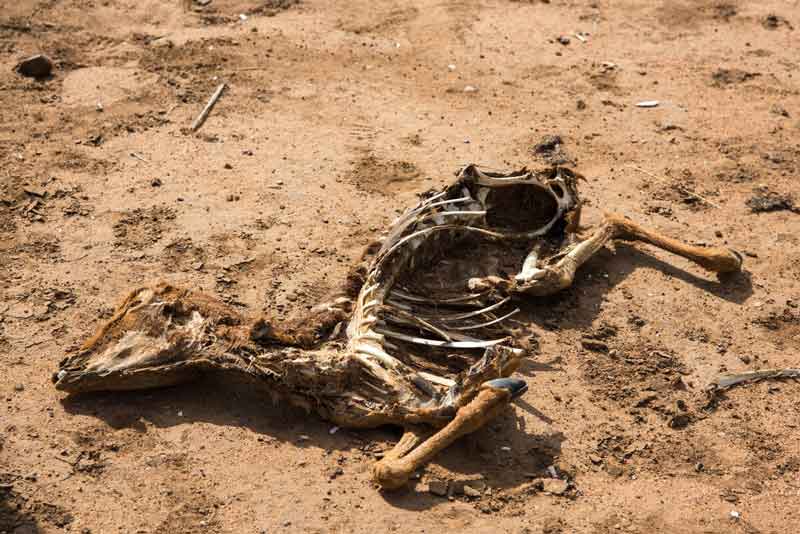
The remains of the favourite sheep of a little boy named Ejiem, in Kenya. Climatic change around the world has contributed to prolonged drought, stripping the land of light-green, growing things. When livestock perish, people's livelihoods die, too. Photograph: Jon Warren
Recurring drought due to climate change is just 1 challenge. Many pastoralists (people who enhance, tend and sell livestock) have poor access to markets and limited entrepreneurial skills. This leaves them highly vulnerable, barely subsisting instead of growing their income.
World Vision helps reduce families' vulnerability to climate change, increase their income and improve their food security. Livestock insurance is 1 of the ways that is accomplished, forth with village savings and loans associations to tide families over in disaster.
As a result, pastoralists are working together to better well-existence. Hither's 1 example of livestock insurance at work for pastoralists.

Maasai herders in Tanzania move their livestock on a seasonal rotation. When at that place'south no vegetation to be found, their livelihoods are at hazard. Photo: Jon Warren
Without measures like insurance, families may have no selection but to sell off livestock when they're unable to keep them alive. Alternatively, they may search tirelessly for water and pasture for their herds – only to run out of options.
Globe Vision works with providers to assistance families secure insurance and works with them to improve skills and connections. As a upshot, even remote villages tin can get commercial hubs for trade – despite climate change.
Babyhood memories of climate change
Kioko Munyao, a climate specialist with World Vision Canada, remembers conversations about climate change, as a boy growing up in Kenya. "In Grade seven, they taught usa that the Sahara Desert was rapidly encroaching," he remembers. "But somehow, the expected desert expansion never really happened. Otherwise, it would have reached Southern Africa by now."
Rather, the atmospheric condition patterns hastening that encroachment were long-term and cyclical. They resulted in something called a vegetation "transition zone"—non an actual expansion of the desert. The transition zone is where dry, arid weather condition of the desert see up with the moister region of the tropics. It creeps one management in wetter years and another in dryer ones.

Natural climate cycles affect rainfall in places similar the Sahara Desert. Massive droughts brought on by climate change can make matters worse, forcing people who accept existed as nomads for centuries to live in urban areas. Photo: John Shahid
"Such cyclical patterns withal exist," says Munyao, "just they're now affected past homo-made changes." The event? Increased frequency and unpredictability of drastic conditions events similar floods and droughts due to climatic change.
Helping communities face up climatic change
World Vision can't opposite global warming, just there'south a bang-up deal that communities can practice locally to reduce its effects on their lives and thrive. Globe Vision begins by educating communities on the impact of their activities on local weather patterns, says Munyao.
"When rain falls in a forested area, the woods cover does an excellent job of trapping rain on the ground," he explains. "Much of that gets absorbed by the trees and plants and they grow strong and good for you." Groundwater, the h2o held underground in the soil or pores and crevices in the stone, as well increases.
But at that place's a second benefit, says Munyao. "Considering of all that green cover, water evaporates every bit vapour. It transforms to pelting, which falls on the nearby communities. Then you lot've got a healthy micro-climate."
When local families clear the land for farming or fuel, in that location's nothing to prevent rainfall from just running off the land. "Y'all don't get the same evaporation," says Munyao. "That means in that location's less rainfall in the surface area. Everything dries upwardly. Erosion washes abroad the rich soil, making it even more difficult for plant growth to happen."
In that location are means this can be reversed, every bit World Vision is discovering in partnership with communities.
Rescuing state from climate change
World Vision pioneered a reforestation project which restored nearly 7,000 acres of state in southwestern Ethiopia. It won global recognition by condign the outset on the continent to earn United Nations-administered carbon credits. The project was supported by the World Bank's BioCarbon Fund.

Families in Humbo, Ethiopia, worked to transform their landscape, increasing hope in the face of climate change. This was the glorious consequence. Photo: Silas Koch
The community-managed climatic change mitigation projection happened in Humbo, Ethiopia. World Vision worked with local farmers to aid restore degraded and deforested country. This means that they:
- allowed native trees and shrubs to regrow on degraded forest land from alive stumps, underground roots and soil seedbanks;
- pruned mainly to manage densities and run into local needs for firewood;
- carefully managed livestock and closed off entire areas to both humans and animals in order to allow native vegetation to regenerate; and
- succeeded in restoring trees to the mural, and producing firewood, berries, fruits and nuts to consume and sell.

Photo: World Vision
Before the project (left)
The expanse was bare of trees though a few shrubs remained. Loftier rainfall had led to wink-flooding in the area, destroying roads and bridges. There was extensive erosion and large amounts of topsoil had been lost. It was a struggle to grow annihilation in the area – the trees themselves couldn't regrow without the right soil and nutrients.
After the projection (correct)
In nearly a decade, the surface area became lush and green, with a rich biodiversity and ample tree cover. The vegetation acts to foreclose erosion. This means better water filtration, reduced flash-flooding and more stable farm production. The Humbo project has become a model for farmer-managed natural regeneration efforts in other African countries.
The Humbo project is helping alleviate poverty in three ways:
- by providing more grass to people to cut-and-carry for their livestock and more firewood,
- by improving basis water and decreased erosion, and
- by creating a new community-based income stream through the generation of carbon offset credits under the Clean Development Mechanism
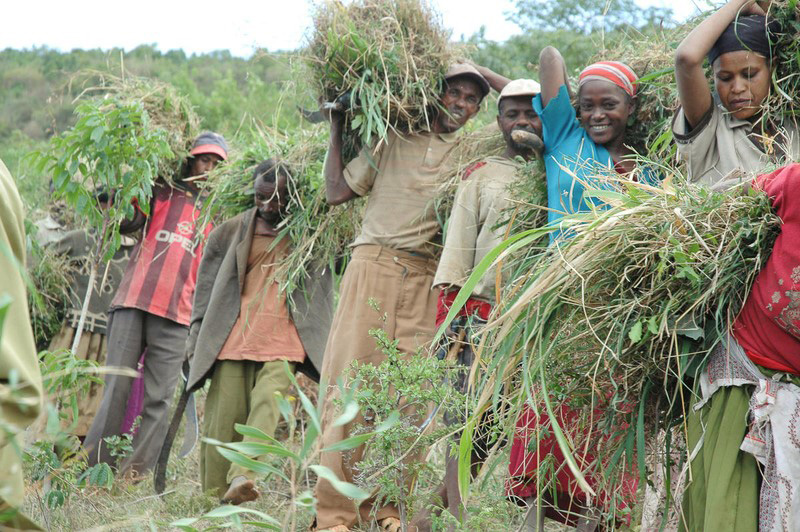
Families in a similar forest restoration project in Ethiopia had plenty of fodder for their cattle. Photo: Aklilu Kassaye
Standing upward to climate alter
Around the globe, World Vision is helping communities empathize the effects of climatic change – and what they can practice to stand up up to them. Children are a critical function of this. In Myanmar, for example, sponsored children in this youth grouping are:
- Learning why natural disasters are increasing in frequency and severity
- Chronicling the impact of climate change in their communities
- Education adults and other children about the impacts of climate alter
- Caring for their customs by planting trees and cleaning up local waterways
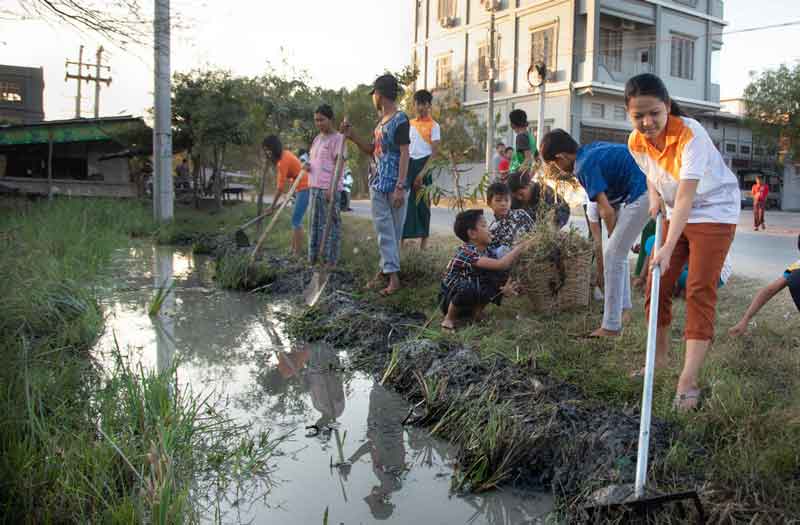
Children in Myanmar are learning about climatic change, and then making changes in their community. They are taking care of their surround and didactics others. Photo: Kathy Htoo and Khaing Min Htoo
How Canadians can help
Canadians can play a part in helping families overseas survive climate change. As the David Suzuki Foundation notes, we can make changes in our ain lives to reduce global warming overall. This could assistance people nosotros've never met in some of the earth's poorest countries.
Earth Vision invites Canadians to donate a climate change gift through their Gift Catalogue, offering families overseas:
- Wood-conserving stoves – Fueled by vegetable debris, eco-stoves are easy and condom to use. Families utilize them to cook, sanitize water and estrus their homes on cold nights.
- Solar lights – Lights are a clean energy source. Y'all'll give children a way to study at night and families more than time to enjoy together.
- Solar panels – Panels help provide energy for wellness facilities and irrigation systems.
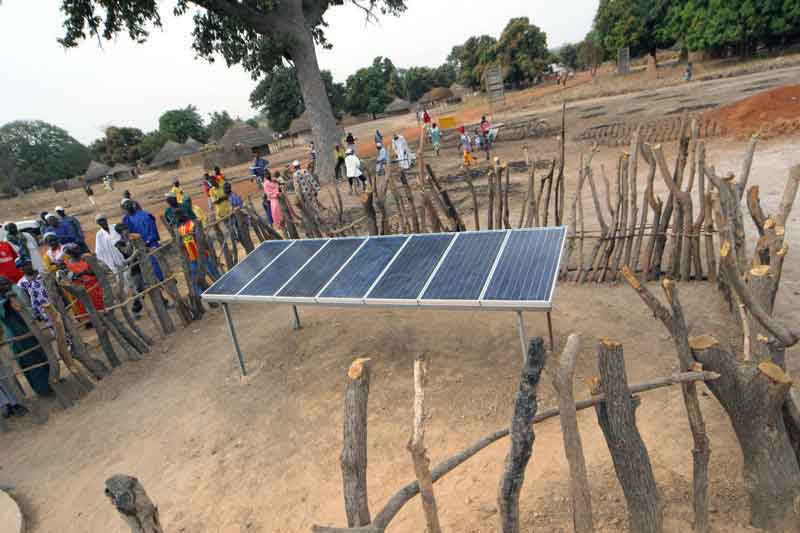
Solar panels provide energy for irrigation systems and health clinics, helping families and communities thrive despite climate change. Photo: Paul Bettings
Source: https://www.worldvision.ca/stories/climate-change/how-climate-change-impacts-poverty#:~:text=Here's%20how%20climate%20change%20is,or%20sweep%20away%20people's%20homes.
Posted by: thompsonmecer1954.blogspot.com

0 Response to "How Climate Change Affects The Global Poor"
Post a Comment